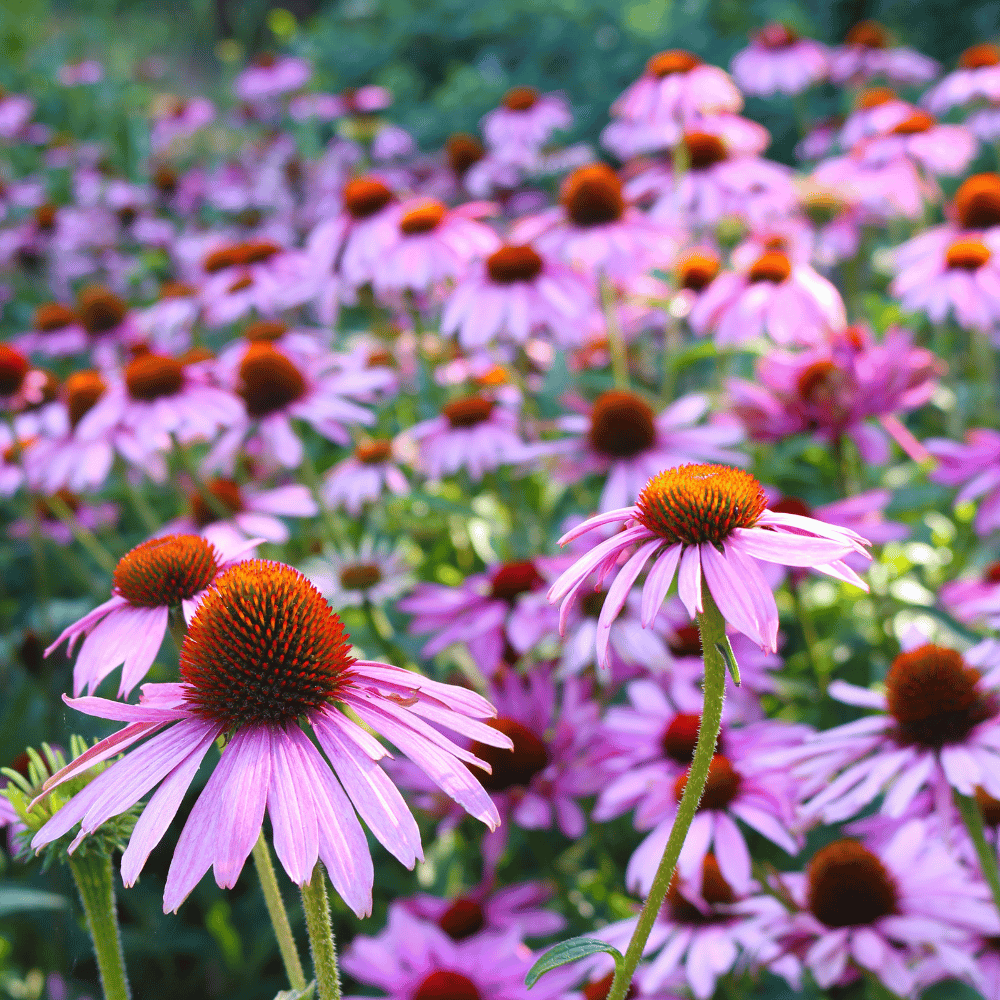Echinacea, commonly known as coneflower, is a perennial herbaceous plant native to North America. Long admired for both its ornamental beauty and its medicinal properties, Echinacea stands tall and bright in meadows, borders, and wildflower gardens. Its bold daisy-like blooms and central cone attract bees, butterflies, and gardeners alike.
Tough, drought-resistant, and easy to grow, Echinacea brings resilience and grace to any space. With its upright growth and long blooming season, it is a mainstay for pollinator-friendly and low-maintenance gardens.

Portrait of the Echinacea
A member of the Asteraceae family, Echinacea includes around 10 species, the most popular of which is Echinacea purpurea. It’s known for its large, central spiny cone surrounded by petals that tend to droop backward, resembling a sunburst.
- Type: Herbaceous perennial
- Family: Asteraceae
- Common species: E. purpurea, E. angustifolia, E. pallida
Foliage and Form
Echinacea plants are clump-forming, with stiff, upright stems and lance-shaped leaves that may be slightly toothed. The foliage is medium to dark green, with a coarse texture that contrasts beautifully against finer-leaved companions.
- Height: 60–120 cm (2–4 ft)
- Spread: 30–60 cm (1–2 ft)
- Growth Habit: Upright, bushy clumps
Blooms and Fragrance
The blooms of Echinacea are iconic: a bold, raised cone surrounded by petals in shades ranging from classic purple to white, pink, yellow, and orange in newer cultivars.
- Bloom Time: Mid-summer to early autumn
- Color: Purple, pink, white, yellow, orange
- Fragrance: Faintly sweet; not strongly aromatic
Flowers are long-lasting and also prized as cut flowers. The seed heads persist into winter, adding texture and providing food for birds.
The Right Time to Plant and Care for Echinacea
Echinacea benefits from spring planting for summer blooms and requires deadheading to prolong flowering. Cutting back the entire stem encourages fresh growth and sometimes a second flush of flowers.
| Month | Planting | Flowering | Pruning (Deadheading) |
|---|---|---|---|
| January | ❌ | ❌ | ❌ |
| February | ❌ | ❌ | ❌ |
| March | ✅ (seeds or transplants) | ❌ | ❌ |
| April | ✅ | ❌ | ❌ |
| May | ✅ | ✅ (early bloom in warm zones) | ✅ (optional) |
| June | ❌ | ✅ | ✅ |
| July | ❌ | ✅ | ✅ |
| August | ❌ | ✅ | ✅ |
| September | ❌ | ✅ (late bloomers) | ✅ |
| October | ✅ (in mild zones) | ❌ | ✅ (cut back for winter) |
| November | ❌ | ❌ | ❌ |
| December | ❌ | ❌ | ❌ |
✅ = Recommended ❌ = Not advised
Ideal Watering, Sunlight, and Environment for Echinacea
Watering
- Water regularly during establishment (first season).
- Once established, drought-tolerant—only water during prolonged dry periods.
- Avoid soggy soil; good drainage is key.
Sunlight
- Prefers full sun (at least 6 hours daily).
- Tolerates light shade, but may become leggy and produce fewer blooms.
Indoor vs Outdoor
- Primarily an outdoor plant, suitable for borders, pollinator gardens, and meadows.
- Not suitable as an indoor houseplant.
Temperature
- Hardy in USDA zones 3–9.
- Tolerates both cold winters and hot summers, provided soil conditions are right.
Ideal Soil Conditions for Growing Echinacea
| Soil Feature | Optimal Condition | Why It Matters |
|---|---|---|
| Soil Type | Sandy or loamy, well-drained soil | Prevents root rot and promotes healthy tuber development |
| Texture | Medium to coarse | Encourages airflow around roots |
| Drainage | Excellent | Essential to prevent fungal diseases and root rot |
| Moisture | Moderate to dry | Overwatering is a common issue with established plants |
| Soil pH | Neutral to slightly acidic (6.0–7.0) | Suitable range for nutrient uptake |
| Fertility | Average to low | Too much fertility can reduce flowering |
Common Problems & Solutions
| Issue 🐾 | Symptoms 🔍 | Solutions 🛠️ |
|---|---|---|
| Powdery Mildew 🌫️ | White powdery coating on leaves | Improve air circulation, avoid overhead watering |
| Aphids 🐜 | Curling leaves, sticky residue | Spray with water or insecticidal soap |
| Leaf Spot 🟤 | Brown or black spots, often fungal | Remove affected leaves, use fungicide if necessary |
| Root Rot 💧 | Wilting, yellowing leaves, mushy roots | Improve drainage, reduce watering |
| Poor Blooming 🌱 | Lots of foliage, few flowers | Avoid excess nitrogen, ensure full sun |
Echinacea is a beautiful, hardy, and pollinator-friendly plant that brings lasting color and structure to any garden. Whether you’re growing it for its ornamental value or herbal uses, it rewards minimal effort with maximal presence and resilience.